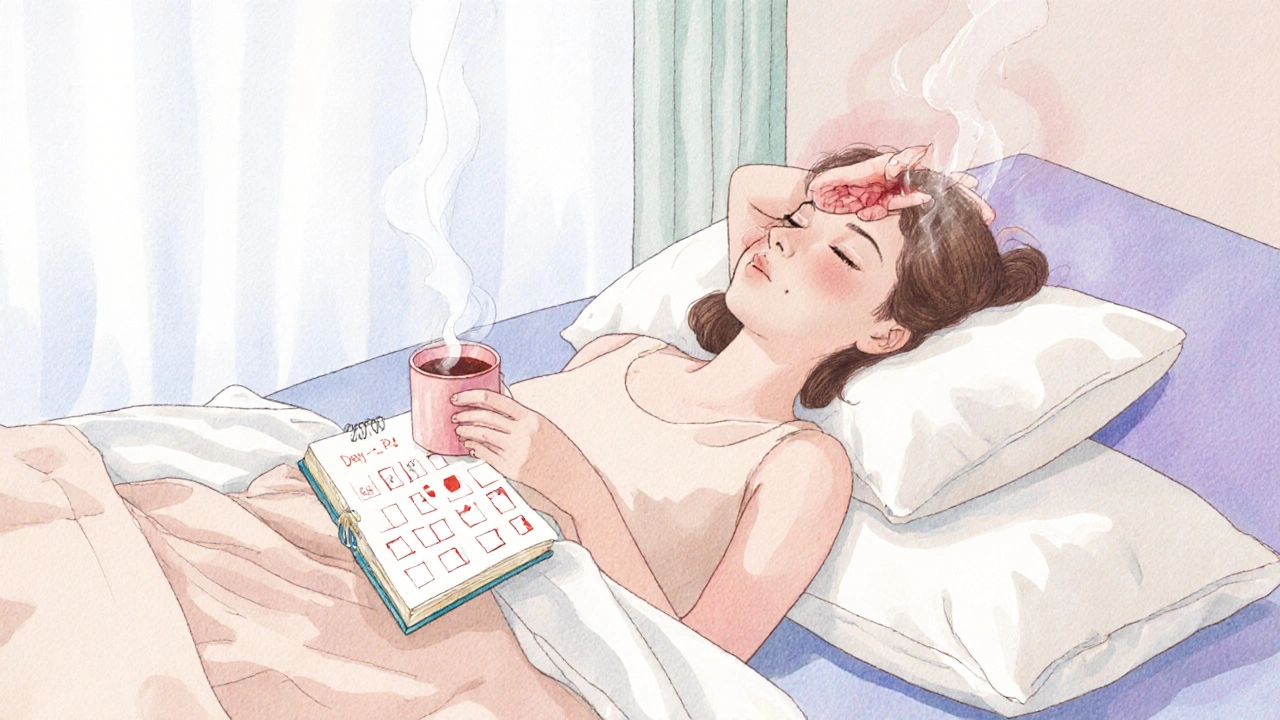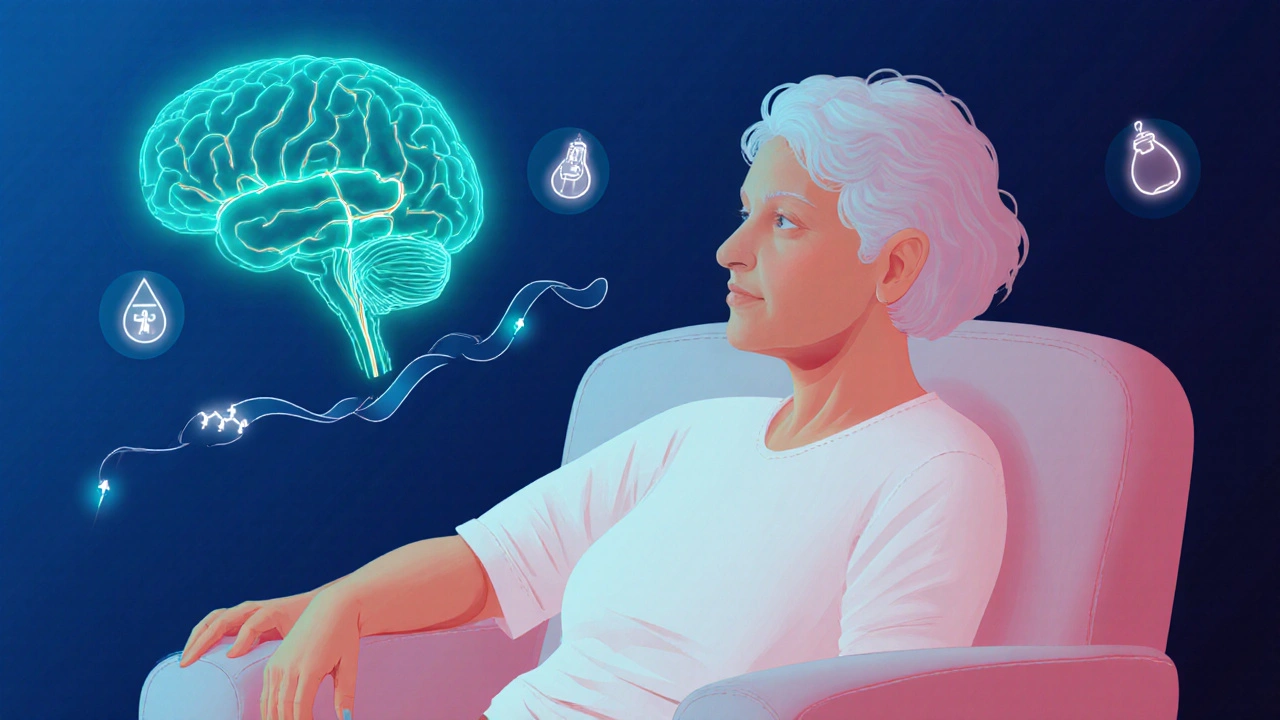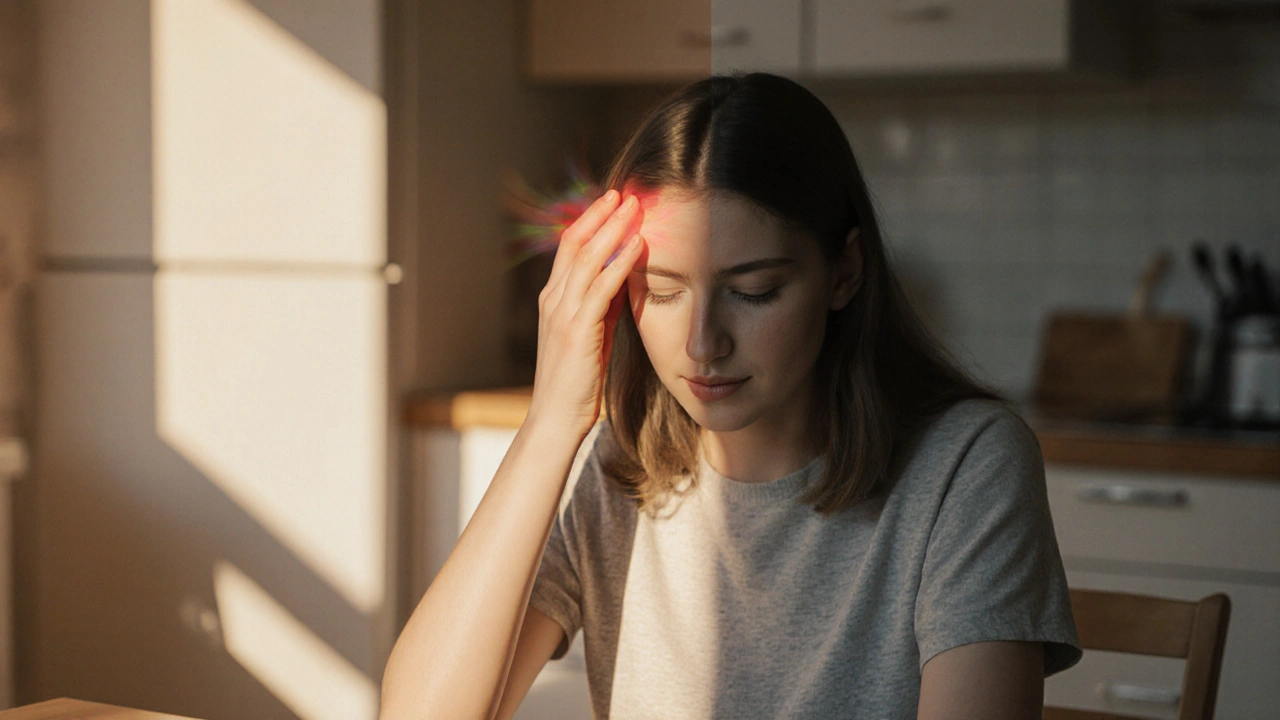Migraine and Hormonal Cycle Tracker
Your Personalized Migraine Insights
Women who suffer from Migraine is a neurovascular headache disorder characterized by throbbing pain, nausea, and sensitivity to light. Often the story gets tangled with hormones: many women notice that their attacks flare up around the period or shift dramatically during menopause. This article untangles the science, points out the warning signs, and hands you practical steps to keep migraines from hijacking your life at any age.
Key Takeaways
- Hormonal swings, especially estrogen drops, are the main trigger for menstrual migraine.
- During perimenopause the migraine pattern can change - attacks may become more frequent, longer, or even improve for some.
- Keeping a detailed headache diary helps you prove the hormonal link and guides treatment decisions.
- Acute options (triptans, NSAIDs) and preventive therapies (CGRP antagonists, beta‑blockers) work differently before and after menopause.
- Lifestyle tweaks-sleep hygiene, stress management, and diet-remain the foundation for any stage.
Why Hormones Matter for Migraine
Both menstruation is the monthly shedding of the uterine lining, driven by a rise and fall of estrogen and progesterone. When estrogen peaks, many women report fewer headaches; the sudden dip that occurs just before bleeding often sparks a migraine. This link is so consistent that the International Headache Society classifies “menstrual migraine” as a distinct subtype.
Menopause marks the end of ovarian hormone production, typically between ages 45‑55. The transition-known as perimenopause-features erratic estrogen levels before they finally settle at a low baseline. Those swings can destabilize the brain’s pain‑modulating pathways, leading to new or altered migraine patterns.
In short, estrogen is a double‑edged sword: enough of it keeps the trigeminal nerve calm; too little or too rapid a change throws the system into overdrive.
Menstrual Migraine: What It Looks Like
Women with menstrual migraine usually meet one of two criteria:
- Attacks occur exclusively on day -2 to +3 of the period (pure menstrual migraine).
- Attacks happen any time but are more common during that window (menstrually related migraine).
Typical features include:
- Throbbing pain on one side of the head.
- Accompanied nausea, vomiting, and sensitivity to light or sound.
- Duration of 4‑72hours if untreated.
Because the trigger is predictable, you can plan both acute and preventive strategies.

Management Strategies for Menstrual Migraine
Track the cycle. A simple spreadsheet or a phone app that records headache onset, severity, and menstrual dates reveals patterns within a few cycles.
Short‑term relief. NSAIDs taken at the first sign of pain work best when started early. Triptans (e.g., sumatriptan) are effective but should be used within 2hours of headache onset for optimal benefit.
Hormonal approaches. Short courses of estrogen patches or combined oral contraceptives can blunt the estrogen drop. The choice depends on your risk profile and whether you’re already using hormonal birth control.
Preventive meds. For women who have frequent menstrual attacks (≥4 per month), doctors may prescribe:
- Beta‑blockers (propranolol)
- Anticonvulsants (topiramate)
- Newer CGRP (calcitonin gene‑related peptide) monoclonal antibodies-e.g., erenumab-show promise because they target the migraine pathway directly and are not hormone‑dependent.
Discuss timing with your clinician; sometimes a short “mini‑prevention” regimen-taking a preventive dose only during the high‑risk window-covers the period without daily medication.
How Migraine Changes During Menopause
When estrogen levels settle low, two broad trends appear:
- Improvement. About 30% of women report fewer attacks after menopause because the erratic hormonal swings disappear.
- Worsening or new onset. Roughly 20% experience more frequent or longer attacks, often linked to perimenopausal fluctuations, weight gain, or sleep disruptions.
Key factors that influence the change:
- Estrogen levels fall dramatically, removing the protective “high‑estrogen” window.
- Stress, anxiety about aging, and co‑existing conditions (osteoporosis, cardiovascular risk) can amplify migraine pathways.
Therapeutic Options for Menopausal Migraine
Hormone Replacement Therapy (HRT). Low‑dose estrogen combined with progesterone can smooth the decline, decreasing migraine frequency for many. However, HRT carries cardiovascular and breast‑cancer considerations, so a risk‑benefit discussion is essential.
Non‑hormonal acute meds. Triptans remain the go‑to for rapid relief. Some women find that rizatriptan nasal spray works better when oral meds cause stomach upset-a common perimenopausal complaint.
Preventive medications. CGRP monoclonal antibodies (galcanezumab, fremanezumab) have shown consistent efficacy regardless of hormonal status, making them a solid choice for post‑menopausal patients.
Adjunctive lifestyle measures. Regular aerobic exercise, magnesium supplementation (400mg nightly), and consistent sleep‑wake times help stabilize the nervous system.

Quick Comparison: Menstrual vs. Menopausal Migraine
| Aspect | Menstrual Migraine | Menopausal Migraine |
|---|---|---|
| Typical trigger | Estrogen drop 2‑3 days before period | Low steady estrogen, perimenopausal fluctuations |
| Age of onset | Teens‑30s (often coincides with first cycles) | 45‑55 (during perimenopause) |
| Frequency pattern | Clustered around days -2 to +3 of menses | May become daily or persistently chronic |
| First‑line acute treatment | NSAID+early triptan | Triptan (often nasal formulation) |
| Preventive options | Mini‑prevention (short‑term hormonal or med) | CGRP antibody, beta‑blocker, HRT (if appropriate) |
| Impact of HRT | Can reduce attacks if estrogen stabilized | Often helpful but weighed against risks |
Practical Tips for Every Stage
- Start a headache diary. Note date, pain level (0‑10), menstrual status, sleep hours, and any medication taken.
- Watch your diet. Some women notice a link between chocolate, aged cheese, or caffeine and migraine spikes during hormonal shifts.
- Prioritize sleep. Aim for 7‑8hours, keep the bedroom dark, and avoid screens an hour before bed.
- Stay active. Moderate aerobic exercise (30minutes, 3‑4times/week) lowers overall migraine frequency.
- Talk to a specialist. A neurologist familiar with hormonal migraine can tailor a plan-especially before starting HRT or contraceptives.
When to Seek Immediate Care
If a headache suddenly becomes the worst you’ve ever experienced, or is accompanied by vision loss, confusion, fever, or a stiff neck, treat it as an emergency. These "red‑flag" symptoms could signal a more serious condition such as a stroke or meningitis, not a typical hormonal migraine.
Frequently Asked Questions
Can birth control cure menstrual migraine?
Combined oral contraceptives can smooth the estrogen dip and reduce attack frequency for many women, but they don't work for everyone. A trial of 3‑6months under a doctor's supervision is the usual approach.
Is it safe to use triptans during pregnancy?
Most triptans are classified as Category C, meaning risk cannot be ruled out. If migraines are severe, doctors may prescribe a limited course after weighing fetal risks against maternal disability.
Do CGRP antibodies work after menopause?
Yes. Clinical data from 2023‑2024 show CGRP monoclonal antibodies maintain efficacy in post‑menopausal women, with a safety profile comparable to younger adults.
What natural supplements help with hormonal migraine?
Magnesium (400mg nightly), riboflavin (400mg daily), and coenzymeQ10 (100mg twice a day) have modest evidence for reducing attack frequency. Always discuss with a clinician before adding supplements.
Why do some women get better after menopause?
When estrogen stabilizes at a low level, the dramatic pre‑menstrual drops disappear, removing a potent trigger. For those whose migraines were primarily hormonal, this can mean fewer attacks.
Understanding the hormone‑migraine connection empowers you to anticipate attacks, choose the right meds, and work with your doctor on a personalized plan. Whether you’re navigating your twenties, mid‑life perimenopause, or enjoying post‑menopausal freedom, the tools above can keep migraines from stealing your day.

Rahul Kr
October 8, 2025 AT 21:52Interesting breakdown on how hormones affect migraines 😊.
Alex Mitchell
October 16, 2025 AT 05:22I was reading the part about estrogen drops and it really clicked for me. The way the article splits menstrual and menopausal migraine makes sense. I wish more doctors would ask about cycles when prescribing triptans. Still, the advice about magnesium could use some more detail woudl be great to see references.
Narayan Iyer
October 23, 2025 AT 12:52Yo, the neuro‑vascular stuff gets dense fast, but the article nails the core idea: estrogen is basically the migraine switch. When it plummets pre‑period you get that classic throbbing, and the perimenopause roller‑coaster adds a whole new layer of chaos. I appreciate the mini‑prevention tip-loading a short‑term hormonal patch just before the window is a slick hack. Also, the CGRP‑mAb mention is on point for chronic cases, especially post‑menopause when hormones aren’t the main driver. Keep dropping the science, it helps the community level‑up.
Ismaeel Ishaaq
October 30, 2025 AT 20:22Finally someone who gets that migraine isn’t just a headache-it’s a hormonal battlefield! The vivid table comparing menstrual vs menopausal triggers is gold. I’d add that caffeine spikes can worsen the dip‑induced attacks, so cutting that out during cycle windows can be a lifesaver. Also, don’t overlook the power of magnesium; many of my patients swear by it. Keep the colorful graphics coming, they make the science digestible for everyone.
Jesse Goodman
November 7, 2025 AT 03:52Hormones are the hidden puppeteers of migraine; pull one string and the pain show starts. 🧠💥 Simple tip: log your cycle in any notes app, it’s free and powerful.
Antara Kumar
November 14, 2025 AT 11:22The article leans heavily on estrogen as the villain, but it ignores the role of lifestyle stressors that can be equally culpable. Not every post‑menopausal migraine is hormonal; many are tied to sleep debt and diet. Also, the blanket endorsement of HRT feels irresponsible without discussing the cardiovascular risks for certain populations.
John Barton
November 21, 2025 AT 18:52Oh great, another guide telling women to pop pills and pray the migraine disappears. 🙄